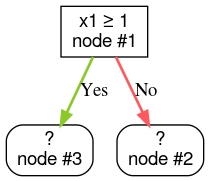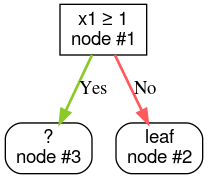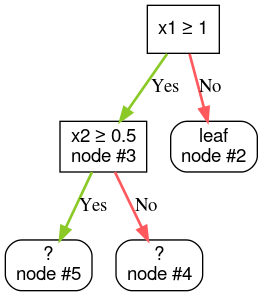与所有监督式机器学习模型一样,决策树的训练目标是尽可能准确地解释一组训练示例。决策树的最佳训练是一个 NP 难问题。因此,训练通常使用启发词语(一种易于创建的学习算法)来完成,该算法会生成非最优但接近最优的决策树。
用于训练决策树的大多数算法都采用贪心分而治之策略。该算法首先创建一个节点(根节点),然后以贪心的方式递归地扩展决策树。
在每个节点,系统都会评估所有可能的条件并为其评分。算法会选择“最佳”条件,即得分最高的条件。目前,只需知道得分是与任务相关的指标,并且条件的选择是为了尽可能提高该指标。
例如,在 Palmer Penguins 数据集(用于本课程后面的代码示例)中,大多数阿德利企鹅和巴布亚企鹅的嘴长度大于 16 毫米,而大多数颊纹企鹅的嘴较小。因此,条件 bill_length_mm ≥ 16 可以对冠企鹅进行近乎完美的预测,但无法区分帝企鹅和巴布亚企鹅。算法可能会选择此条件。

图 7. 种植树的第一步。
然后,该算法会在两个子节点上独立递归重复。如果找不到任何满足条件的节点,则该节点会变为叶节点。叶子预测是根据示例中最具代表性的标签值确定的。
算法如下:
def train_decision_tree(training_examples):
root = create_root() # Create a decision tree with a single empty root.
grow_tree(root, training_examples) # Grow the root node.
return root
def grow_tree(node, examples):
condition = find_best_condition(examples) # Find the best condition.
if condition is None:
# No satisfying conditions were found, therefore the grow of the branch stops.
set_leaf_prediction(node, examples)
return
# Create two childrens for the node.
positive_child, negative_child = split_node(node, condition)
# List the training examples used by each children.
negative_examples = [example for example in examples if not condition(example)]
positive_examples = [example for example in examples if condition(example)]
# Continue the growth of the children.
grow_tree(negative_child, negative_examples)
grow_tree(positive_child, positive_examples)
我们来详细了解训练特定决策树的步骤。
第 1 步:创建根目录:

第 2 步:扩展节点 1。找到了条件“x1 ≥ 1”。 系统会创建两个子节点:

第 3 步:扩容节点 2。未找到任何满足条件的设备。因此,将该节点转换为叶节点:

第 4 步:扩展节点 3。发现了条件“x2 ≥ 0.5”。系统会创建两个子节点。

还有其他方法可以扩展决策树。一种常见的替代方法是全局优化节点,而不是使用分而治之策略。
growing_strategy="BEST_FIRST_GLOBAL" 参数启用全局增长。如需了解详情,请参阅
文档。给定节点的可能条件数量可能非常多,通常是无限的,具体取决于输入特征的数量和类型。例如,给定阈值条件 $\mathrm{feature}_i \geq t$,对于 $t \in \mathbb{R}$,所有可能的阈值值的组合是无限的。
负责查找最佳条件的例程称为拆分器。由于需要测试许多可能的条件,因此分屏器是训练决策树时的瓶颈。
分屏器最大化的得分取决于任务。例如:
有许多分屏算法,每种算法对以下各项的支持各不相同:
- 特征的类型;例如,数值、分类、文本
- 任务;例如,二元分类、多类分类、回归
- 条件的类型;例如,阈值条件、集合内条件、斜线条件
- 正则化条件;例如,用于阈值条件的完全分隔符或近似分隔符
此外,还有等效的分屏变体,它们在内存用量、CPU 用量、计算分布等方面具有不同的权衡。
